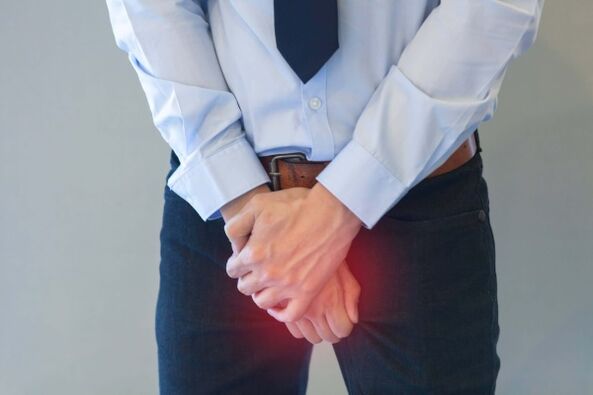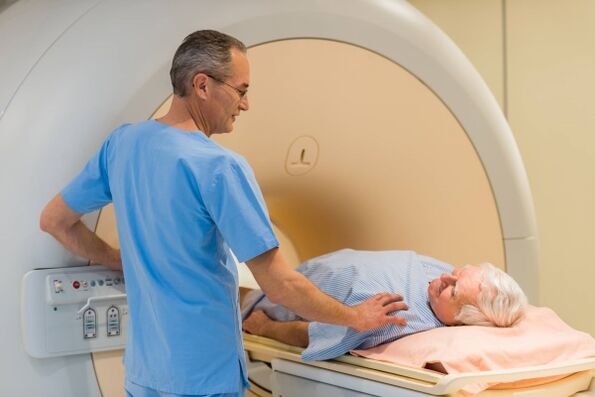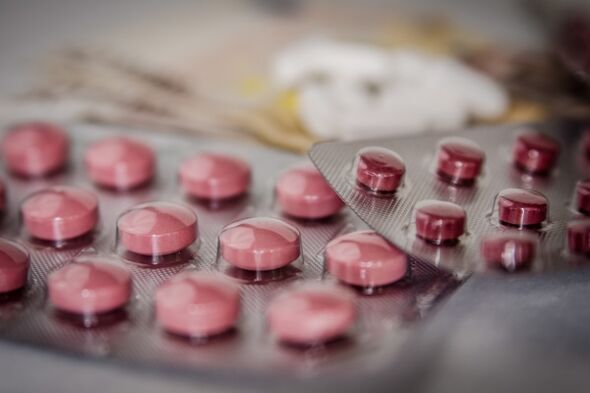Acute prostatitis is characterized by a pronounced clinical picture. Pathology is dangerous with a number of serious complications, so it requires timely and complex treatment. How to recognize and treat a disease is described in this article.
Acute prostatitis is an inflammatory disease, which is associated with pronounced painful sensations and can pose a major health risk. For a successful prognosis of the disease, you should consult your doctor in time for diagnosis and prescription of competent treatment.
General characteristics of the disease
Acute prostatitis is an inflammatory process that develops rapidly in the prostate gland. It has four stages of development:
- Catarrhal.At this stage, the gland swells slightly, the inflammation only affects the mucosa of the gland excretory ducts. This period is the most favorable moment for treatment - if you start at this moment, you can get rid of the disease in less than two weeks. The nature of the inflammation is not purulent, but the edema that appears blocks the ducts, preventing the secretion from leaving the glands. Stagnation begins.
- Follicular.As a result of stagnation, the bacteria that have entered the organ begin their activity already in it. Since the organ is made up of cells, grouped into lobules and separated from connective tissue, inflammation first affects a part.
- Parenchymal.Inflammation passes from one lobule to another, there are many pustules in different parts of the gland.
- Purulent abscesses.Pustules coalesce into one, and a vesicle filled with purulent contents forms in the gland. Over time, it can erupt, pus spreading, entering the space around the prostate and bladder, urethra or rectum. When an abscess opens, the pus does not come out completely, and this becomes a new round in the inflammatory process.
How quickly it will develop and how the pathological process will end depends on a number of factors: the reasons for the inflammation, the timing and the appropriateness of the treatment.
Causes
In 90% of cases, the cause of acute prostate inflammation is an infectious lesion. The causative agents can be one or more types of bacteria and viruses:
- Gonococci are one of the most dangerous bacteria, they quickly start purulent processes.
- Trichomonas is the leader among sexually transmitted microorganisms. It penetrates the intercellular space of the gland, therefore, requires a long stubborn treatment.
- Chlamydia - in addition to toxicity, they are able to attach to erythrocytes, increasing their sedimentation rate and impeding blood circulation to the affected area. They penetrate deeper than Trichomonas.
- Staphylococci, golden appearance is especially common. It can survive in any tissue and organ, causes suffocation and makes blood thicker.
- Ureaplasma is a combination of unicellular and viral. It can enter the prostate from the urinary tract or through unprotected intercourse.
- Escherichia coli is a gram-negative bacterium, a common causative agent of acute inflammation. It enters the body as a result of inadequate hygiene during food preparation.
This is not a complete list of bacteria and viruses that can cause acute inflammation of the prostate gland.
Often the reason lies not only in infections that can live in the body for a long time with almost no symptoms. They begin to develop rapidly when there are contributing factors to this:
- Regular or single hypothermia. The cold weakens the body's defenses and makes it harder for them to contain pathogenic bacteria, especially if hypothermia is associated with daily work.
- Irregular sex life. Stagnation of glandular secretion (which is an integral part of sperm) promotes the multiplication of bacteria.
- Management of infections. These can be infections that result from unprotected sex, or bacteria that have caused mild inflammation in the urinary tract. The consequences of a purulent sore throat that does not completely heal in the form of streptococci can also provoke inflammation. Tooth decay can also cause prostate cancer.
- Weakened immunity. If, as a result of illness or uncontrolled intake of antibiotics, the body's defenses become inadequate, bacteria will surely emerge.
- Non-compliance with the rules of personal hygiene.
Symptoms of Acute Prostatitis
The symptoms depend on the stage of the disease.
During the period of catarrhal prostatitis, there is a slight discomfort and a feeling of heaviness in the perineum, the desire to use the toilet at night becomes more frequent. Urination is accompanied by burning and pain. The gland itself is normal or non-critically enlarged, palpation examination causes pain. The temperature remains normal or rises slightly. No intoxication, general well-being.
The follicular period has more manifestations. The pain increases, becomes constant, sometimes radiating sharply to the penis, sacrum or rectum. Urinary retention appears, as urination is difficult due to acute pain. Stools are also associated with severe pain.
The temperature rises to 38 degrees and remains at this level. The prostate gland increases significantly in size, has a dense consistency, is tense, its touch in some places causes sharp pain.

Parenchymal prostatitis is very difficult. Appetite disappears, chills appear, general weakness. Frequent urge to go to the toilet with short urination is replaced by acute urinary retention. Trying to empty the bladder or bowel becomes almost impossible due to the unbearable pain. It is aggravated by constipation and a full bladder, spreads throughout the perineum, a slight relief can only come in a prone position with compressed legs.
The temperature rises above 39 degrees. Inflammation begins to spread to other organs, the mucosa is secreted from the rectum. The prostate gland has a vague outline, it is enlarged and painful. Palpation may not be possible due to edema.
The formation of an abscess is associated with the localization of the acute pain point - where the abscess appeared. The passage of urine, feces and gas is extremely difficult, accompanied by strong throbbing pain that spreads to the intestines. The temperature is maintained above 39. 5 degrees, chills appear, fever and sometimes a delusional state appears.
Then, suddenly, relief comes: the pain goes away, the temperature drops. However, this does not mean that the patient has healed: the fact is that the abscess has erupted and urgent procedures are now needed to cleanse the body of the pus, because the negative consequences can be very different.
diagnostic
Diagnosis is made on the basis of an assessment of the patient's complaints, analysis of urine, blood and prostate secretions. Moreover, they use the method of digital diagnosis of rectum, ultrasound and CT.
The severity of urinary disorders is assessed using uroflowmetry.
A general urine test allows you to identify the disease in the earliest stages, when the characteristic symptoms are still absent. The alkaline acidity index itself indicates the development of inflammation.
Bacteriological examination of urine allows you to determine the nature of inflammation and its causes. Changes in the color, odor, or consistency of urine are not considered absolute evidence of acute prostatitis.
A complete blood count is the basis for studying the disease. Characteristic indicators of acute prostatitis are low hemoglobin levels (normal 130 g / l), high levels of urea and creatinine, as well as leukocyte level and erythrocyte sedimentation rate. Protein should not be normal, as well as a high leukocyte level - should not have more than 5 units.
Specific PSA analysis allows you to identify not only inflammation but also malignant formation.
PCR research allows you to quickly identify any genital infections that are often the cause of acute prostatitis.
Ultrasound allows you to determine the size of the prostate gland, its edges, the presence of the spot and diffuse changes. If an abscess has formed, this study can determine its size and location. If possible, the study is conducted fairly; if pain and swelling do not allow this, gland examination is performed on the abdominal side.
Sometimes ultrasound is performed by observing the change in the frequency of the sound reflected by the organ. This allows you to estimate the blood supply to the prostate - vascularization, which may increase or decrease depending on the type of inflammation and its stage. Allows you to distinguish a cancerous tumor from acute prostatitis.
If the doctor determines that surgery is necessary, he or she prescribes CT or MRI to examine the details of the inflammatory process.

Treatment of acute prostatitis
Disease therapy is always complex, including taking various medications, procedures, and diet. The treatment can last about 2 months.
The main task of the doctor is to eliminate the cause of inflammation, which most often consists of infection. For this, antibiotics (alone or in combination) are prescribed. The choice of a drug depends on several factors:
- pathogen susceptibility;
- concomitant diseases of the patient;
- mode of action of the drug.
Self-diagnosis and therapy are not possible: an effective drug is selected on the basis of laboratory tests
To combat the causative agents of an acute inflammatory process, fluoroquinolones and third-generation cephalosporins are most often used. For the treatment of acute prostatitis, the bactericidal effect of the antibiotic is fundamentally important.
Depending on the stage and condition of the patient, the dose and form of release of the drug are chosen: the more neglected the situation, the higher the dose and the more important it is for the drug to reach its destination faster, therefore, drugsin the form of injections are more preferable than tablets.
It is necessary to normalize urine output and secretions. If the urine retention has returned to an acute form, a trochanter epicistomy is prescribed - a bladder puncture, followed by the insertion of a thin tube.
If such drastic measures are not required, non-steroidal anti-inflammatory drugs are prescribed to restore normal urination, which relieves swelling and pain. Medications are prescribed in the form of tablets, injections or rectal suppositories.
If acute prostatitis has turned into an abscess, treatment depends on what stage it is at. The infiltration phase is treated with active therapy with antibiotics and immunostimulants. A blockage is given with painkillers to help the patient overcome the pain.
If an abscess has formed, treatment is possible only with the help of surgical intervention: the purulent bladder is opened, washed and drainage is installed. After surgery, therapy is prescribed to fight germs and intoxication.
Treatment of acute prostatitis is not limited to relieving symptoms. The course of antibiotics should be taken to the end, and not until the pain disappears.
Once the seizure itself is removed, it is time for physiotherapy. It includes UHF and microwave procedures, electrophoresis and prostate massage. The purpose is to alleviate swelling (if left untreated), to improve the secretion of glandular secretions in order to avoid overload.
It is important to stick to your diet throughout the course of treatment. You must reject the following products:
- alcoholic beverages, coffee, fried and salty - contributes to the occurrence of overload;
- cauliflower, apples, legumes and raw vegetables - cause bloating, as a result of which the pelvic organs, including the prostate, are compressed;
- acidic, internal drinks - they irritate the urinary tract.
The diet should include cereals, boiled vegetables, dairy products and ripe fruits. All this contributes to the normal functioning of the intestines. It is necessary to observe the drinking regime, drinking at least 2 liters of fluid (water, fruit drinks, juices) per day. The more often the urinary tract reddens, the lower the risk of inflammation.
Vitamin complexes and peptides should be taken to improve tissue regeneration and rapid restoration of normal gland function.

The favorable course of treatment is judged by the restoration of glandular tissue, the normalization of chemical indications of prostate secretions, the absence of pathogens in the analysis, and the general well-being of the patient.
Prediction and complications
The earlier treatment is started, the faster and easier it is to get rid of acute prostatitis. Complication is any other stage of the disease, the chronic course of the disease, the spread of inflammation to other organs, infertility, sepsis. If the disease has started, it may be necessary to remove the gland yourself.
With timely treatment, at the end of the course of therapy, all body functions are restored, work capacity is fully restored.
prevention
Preventive measures include the absence of unprotected sexual intercourse (to exclude STIs), careful hygiene and timely treatment of inflammatory processes in the urinary tract. It is necessary to maintain immunity, not to start carious teeth and to carefully treat any infectious diseases.
You also need to rule out factors that contribute to the development of the disease. For this you need:
- have a regular sex life with a partner;
- avoid hypothermia (permanent and once);
- give up alcohol, smoking and a sedentary lifestyle;
- regularly undergo a routine examination by a urologist;
- do not treat yourself at the first signs of inflammatory processes;
- adhere to a balanced diet;
- take vitamins, especially during periods of infectious disease spread.
Acute inflammation of the prostate occurs due to infections that develop under favorable circumstances. Treatment is performed with antibiotics, anti-inflammatory drugs, painkillers and vitamins. During the therapy period, it is important to adhere to a diet and drinking regime.































